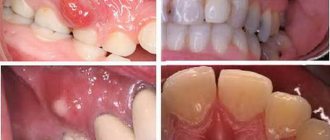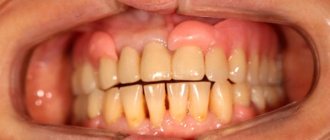What is flux and its types
Flux is an inflammatory process of the soft tissues of the periodontium and periosteum.
The scientific name of the disease is periostitis. It can occur on the gum under any tooth (or above it, if we are talking about the upper jaw). Caused by infection of dental tissues. The process of progression of periostitis goes through four stages (if you do not consult a dentist in a timely manner). The first is characterized by slight pain in the gums, “radiating” to the tooth. The second is the appearance of swelling and redness at the site of tissue infection (the tumor visually resembles a small sac). The third is an increase in body temperature, discharge of pus and swelling of the cheek due to inflammation. The fourth is manifested by severe throbbing pain and increased swelling. Types of flux:
- ordinary - the inflammatory process does not affect the periosteum;
- fibrous – inflammation spreads to the periosteum;
- orthodogenic – infection of bone tissue occurs (osteomyelitis);
- albuminous - a chronic form with a slight increase in temperature and periodic suppuration.
How to avoid deletion
In order to avoid complications, the most important thing is to seek help from a dentist in time. Timely treatment will help save the tooth.
With timely, qualified assistance, swelling and pain will disappear within three days.
If therapeutic help is not enough, surgical intervention is started.
Stages of surgical treatment
- anesthesia;
- antiseptic treatment;
- removal of purulent formation and surrounding inflamed tissue;
- removal of the tooth itself;
- fixation of drainage for the outflow of pus;
- suturing.
After several days, the drainage is removed.
After removal, the main thing is to follow all the dentist’s instructions to avoid any complications.
Causes and mechanism of flux occurrence
As already mentioned, the cause of periostitis is infection. It may be caused by the following factors:
- the presence of carious lesions on the teeth;
- injury;
- infection during treatment;
- poor oral hygiene.
And yet the most common cause of the disease is caries. If a person does not go to the dental clinic, pathogenic microflora destroys tooth enamel and then penetrates inside the tooth. Then pulpitis develops, accompanied by acute pain. If left untreated, the pain gradually stops as the nerve endings die. But the spread of infection does not stop, it reaches the tooth root, causes inflammation of the gum tissue, in which the pathological process begins with the formation of pus. Flux is formed.
Flux treatment
Treatment should take place in a specialized dental clinic. The duration and complexity of treatment depends on the area of the tooth, the location of the flux, the presence or absence of pulpitis and other diseases, as well as the stage of development of the disease - early or late.
The early stage of development is considered to be the period before the appearance of purulent discharge in the affected areas of the tooth. Most often, early treatment is accompanied by the use of antibiotics and painkillers under the strict supervision of a dentist. Remember that many antibiotics have a number of serious contraindications, and their prescription can only occur after the doctor makes sure that you are not at risk and are not allergic to certain components of the medicine.
Treatment of the late stage of development cannot be carried out without surgical intervention. At this stage of the disease, it is necessary to remove the abscess in time. The operation is performed under local anesthesia; you will not feel anything at all. After removing the abscess, relief occurs within twelve hours. The doctor prescribes painkillers and antimicrobials to the patient. It is highly undesirable to engage in heavy physical labor after surgery; it is better to avoid unnecessary stress on the body. Complete restoration of the oral cavity and body after surgery takes three days.
The most radical way to treat gumboil is tooth extraction. It is used only in the most advanced stages, when an abscess has already begun - the spread of pus into the soft tissues of the body. Pus getting into the facial muscles, neck muscles, and then the spread of pus throughout the internal organs is very dangerous. Known fatalities.
As you can see, dental flux is not a harmless, mild disease, but a serious threat to the health of your body. Do not rely on your own strength and contact the dentist at the first sign.
Symptoms
- The formation of a small lump on the gum under (above) the tooth
- Throbbing pain radiating to the back of the head, chin, temple
- Redness of the gums
- Swelling of the cheek due to inflammation
- Increased pain when touching a tooth next to a lump
- Deterioration of general condition caused by intoxication
- Temperature increase (low to high)
- Enlarged lymph nodes in the neck
Note: sometimes swelling on the cheek occurs without any apparent reason or pain. But nevertheless, if this symptom appears, you need to consult a dentist as soon as possible. The doctors in our network of clinics have extensive experience in treating flux, regardless of its type and complexity of the clinical case.
Symptoms of gumboil
Flux on the gums in adults occurs much more often than in children (approximately 80-90 percent of all cases). A characteristic feature of the pathology is that it does not go unnoticed. This is one of the most unpleasant diseases, causing severe discomfort. The most striking symptoms are the classic purulent flux.
Symptoms
- Severe throbbing pain.
- Inflammation and swelling of soft tissues. At the advanced stage, the side of the face on which the flux is diagnosed swells.
- Enlarged lymph nodes.
- Discomfort and pain when eating and talking.
- Flux of the lower tooth (in the molar area) can lead to numbness of the lip and part of the chin.
- Weakness, headache, fever.
What happens if flux is not treated?
Many patients, when symptoms of periostitis appear, hope that everything will “resolve” on its own, as people say. This is an erroneous and dangerous opinion, following which can have dire consequences. This situation can have a particularly serious impact on the child’s health, because the protective immunity at an early age is not well developed. If left untreated, the infection remains in the body, causing the emergence of new diseases, some of which can result in sepsis and death. What is most likely to happen? We list them according to the severity of the problem.
Consequences of untreated flux:
- abscess (abscess) - the formation of a purulent sac;
- phlegmon - an extensive inflammatory process after the rupture of an abscess;
- osteomyelitis of the jaw - inflammation of the tissues of the jaw bone;
- inflammation of the sinuses of the skull - the sphenoid, maxillary and frontal sinuses are involved in the pathological process. Sometimes the infection penetrates into the brain tissue.
Important: specialists from the “Smile” clinic network recommend starting treatment as early as possible. The faster the inflammation is stopped, the less effort will be required to eliminate the problem and restore the patient’s health.
Gums gumboil - what is it?
Before we tell you what helps with flux and what to do if it appears, we will describe this ailment. In the medical field, the disease is called periostitis. Its occurrence is promoted by inflammation of the periosteum tissue.
Visually, the pathological focus resembles an elastic sac filled with purulent contents. Its borders are red and painful. If the outflow of necrotic masses is not ensured in time, the pathogenic microorganisms contained in them can enter the systemic bloodstream and spread throughout the body.
Treatment algorithm
The treatment protocol for periostitis involves a combination of surgical, medicinal and physiotherapeutic methods:
- taking (or a course of injections) antibiotics to destroy pathogenic microflora;
- opening the purulent sac (using local anesthesia), and in difficult cases, installing temporary drainage to drain the pus;
- eliminating the cause that caused the formation of flux: treating a tooth or extracting it if therapeutic measures are inappropriate, cleaning periodontal pockets;
- treating the wound with an antiseptic (gel, rinsing) until it is completely healed;
- course of physiotherapeutic procedures.
Expert advice: after opening a purulent sac, you should not apply warm compresses or take antibiotics that have not been approved by the doctor. If pain continues more than 8 hours after surgery, you should contact the clinic immediately.
Treatment methods
The attending physician should tell you after the examination how to treat gumboil and what measures need to be taken to achieve a successful result. The mechanism is approximately the same, but each clinical case has its own nuances. Today, several techniques are used aimed at eliminating the disease and its manifestations. As a rule, they come together.
Antibiotics for gumboils
Antibiotic treatment is an important stage of rehabilitation. The most effective antibiotics for fighting inflammation and infection are Metronidazole, Lincomycin, Amoxiclav and their analogues. Any tablets and antibiotics for tooth flux should be taken only as prescribed by a doctor!
Physiotherapy
Used as an additional measure to reduce inflammation and speed up recovery. Recommended procedures include electrophoresis, laser and ultrasound therapy.
Therapeutic treatment
It is carried out if it is decided to save the tooth. This includes endodontic treatment and filling of root canals, as well as resection of the root apex if necessary. If the cause of the flux is periodontitis, then a series of manipulations are carried out to eliminate the accumulation of bacteria in the periodontal pockets.
Surgical procedures
This includes tooth extraction and periostotomy - the main procedure for treating flux. The doctor makes an incision into the purulent sac, and then installs a drain through which the purulent exudate comes out.
Local therapy and rinsing for tooth flux
For better release of pus, pain relief and reduction of swelling, gels and ointments are used topically: Metrogyl Denta, Levomekol, Cholisal. Many people are interested in how to rinse gumboil on the gums. Miramistin and soda solution are usually used for rinsing. As an alternative, you can use folk remedies: decoctions and tinctures of propolis, chamomile, sage or calendula. A tooth after gumboil is still very vulnerable: to minimize the risk of re-infection, these treatment and preventive procedures are very important.
Recommendations from prevention experts
- Timely treatment of caries
- Thorough hygienic care of teeth and gums at least 2 times a day
- Rinsing your mouth after every meal and sugary drinks
- Visiting the dentist for a preventive examination twice a year
- Have it professionally cleaned at least once a year
- Eating firm, raw fruits and vegetables daily
The network of dental clinics “Smile” offers services for the treatment of dental flux in adults and children. Contacting our centers has a number of important advantages:
- highly qualified specialists;
- compliance with examination and treatment protocols in accordance with international standards;
- system of family and cumulative discounts;
- stable price of treatment, depending on the severity of the clinical case.
You can contact any of the branches of our clinic in Moscow, located within walking distance from metro stations:
- Art. Alekseevskaya (VDNKh district, etc. Mira), address: st. 3rd Mytishchiskaya house 3, building 2;
- Art. Shelepikha, address: Shelepikhinskaya embankment, address: building 34, building 1.
Do not delay your visit to the doctor, make an appointment when the first symptoms of periostitis appear. This will significantly shorten the treatment time and save costs. Our specialists will provide effective medical care regardless of the severity of the disease. We will take care of your health!
Prevention
To reduce the likelihood of periostitis, you must:
- Get an annual checkup at your dentist's office. The doctor will check for diseases and carry out professional oral hygiene.
- Brush your teeth two to three times a day. To do this, you need to use high-quality paste and a brush selected by a specialist.
- Treat any dental diseases promptly. After all, very often gumboil is a logical continuation of deep caries.
- Stop smoking and eat right. The diet should be rich in fresh vegetables and fruits. They will provide the body with useful elements and have a positive effect on the condition of the gums.
Summarize. If you want to find out how to quickly get rid of periostitis, be sure to visit a dentist. Don’t “reinvent the wheel” and don’t look for folk recipes. Therapy should be comprehensive, step-by-step. The doctor must be responsible for its implementation. Only then will it be possible to quickly get rid of the disease and the question of how to cure gumboil will be finally closed.










